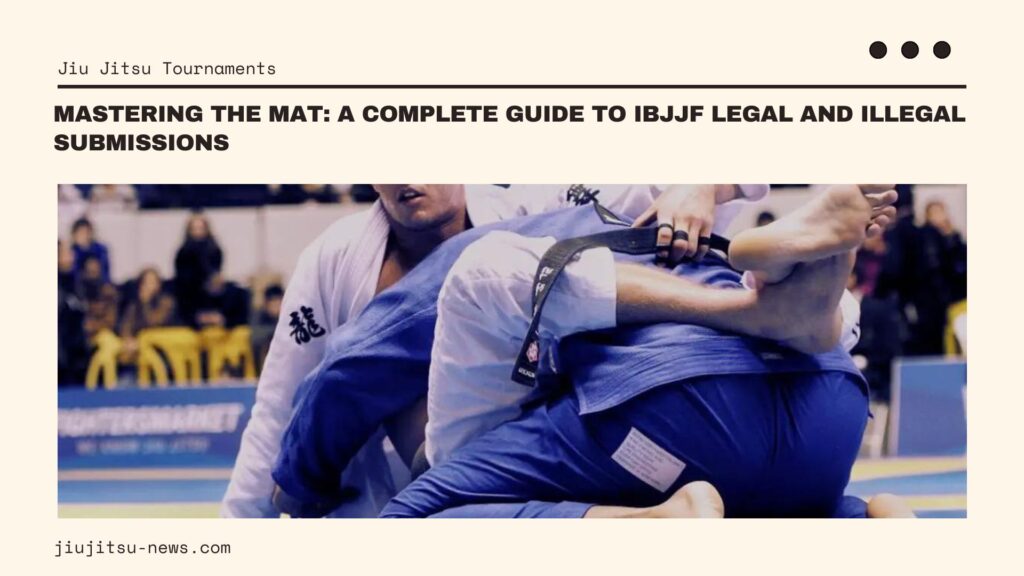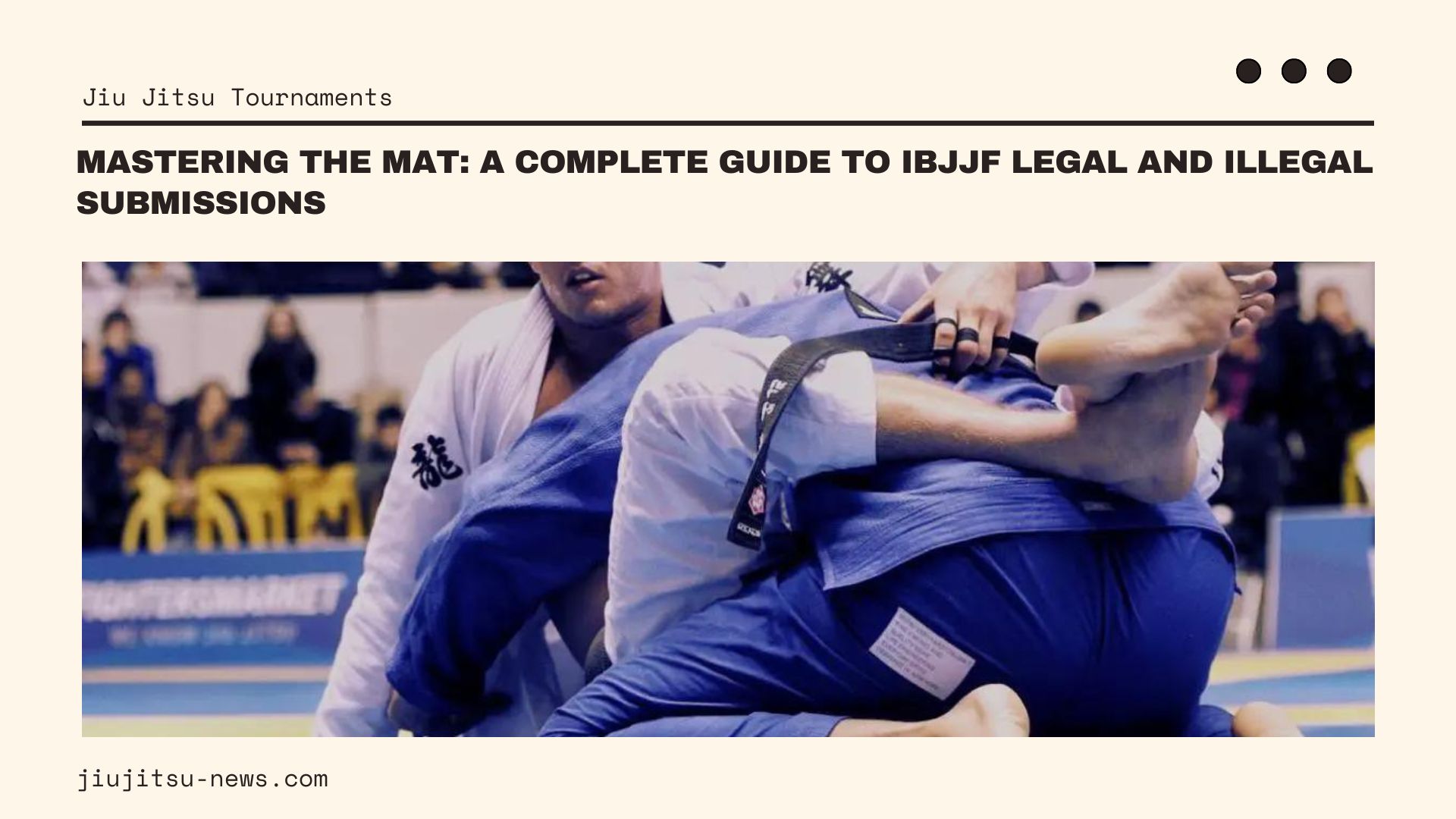
Navigating the rules of jiu-jitsu competitions can be difficult, especially if you are unfamiliar with the legal and illegal techniques outlined by the IBJJF.
Understanding and adhering to these rules is crucial for competitors to avoid penalties or disqualifications during IBJJF events.
Keep reading for a detailed overview of what is allowed and what is not. Also, learn more about the legal and illegal submission techniques that apply to IBJJF competitions.
IBJJF Legal Submissions for Adult Brown and Black Belts
The IBJJF allows several advanced submissions and moves for brown and black belt competitors. See the following table:
| IBJJF Brown and Black Belts Legal Submissions | GI/No-Gi Allowance |
|---|---|
| Submissions that stretch legs apart | legal in Gi and No-Gi |
| chokes with spinal lock | legal in Gi and No-Gi |
| straight foot lock | legal in Gi and No-Gi |
| Ezekiel choke | legal in Gi and No-Gi |
| Frontal guillotine choke | legal in Gi and No-Gi |
| Omoplata | legal in Gi and No-Gi |
| Triangle with dead pulling | legal in Gi and No-Gi |
| Arm triangle | legal in Gi and No-Gi |
| Lock inside the closed guard while the legs are compressing the kidneys or ribs | legal in Gi and No-Gi |
| Wrist lock | legal in Gi and No-Gi |
| Single-leg takedown while | legal in Gi and No-Gi |
| Biceps slicer | legal in Gi and No-Gi |
| Calf slicer | legal in Gi and No-Gi |
| Kneebar | legal in Gi and No-Gi |
| Toe hold | legal in Gi and No-Gi |
IBJJF Illegal Submissions for Adult Brown and Black Belts
The IBJJF doesn’t permit several submissions for brown and black belt competitors, as shown in the following table:
| IBJJF Brown and Black Belts Adult Divisions Banned Submissions | GI/No-Gi Allowance |
|---|---|
| Heel hook | illegal in Gi, but legal in No-Gi |
| Locks twisting the knees | illegal in Gi, but legal in No-Gi |
| Knee reaping | illegal in Gi, but legal in No-Gi |
| Slam | illegal in Gi and No-Gi |
| Spinal lock without choke | illegal in Gi and No-Gi |
| Scissor takedown | illegal in Gi and No-Gi |
| Bending fingers | illegal in Gi and No-Gi |
| Suplex takedown | illegal in Gi and No-Gi |
IBJJF Legal Submissions for Adult Blue and Purple Belts
The IBJJF does permit several submissions for blue and purple belt competitors, as shown in the following table:
| IBJJF Permit Submissions for Blue and Purple Belts | Allowance |
|---|---|
| Submissions that stretch legs apart | legal in Gi and No-Gi |
| chokes with spinal lock | legal in Gi and No-Gi |
| straight foot lock | legal in Gi and No-Gi |
| Ezekiel choke | legal in Gi and No-Gi |
| Frontal guillotine choke | legal in Gi and No-Gi |
| Omoplata | legal in Gi and No-Gi |
| Triangle with dead pulling | legal in Gi and No-Gi |
| Arm triangle | legal in Gi and No-Gi |
| Lock inside the closed guard while the legs are compressing the kidneys or ribs | legal in Gi and No-Gi |
| Wrist lock | legal in Gi and No-Gi |
| Single-leg takedown while | legal in Gi and No-Gi |
| Slam | illegal in Gi and No-Gi |
| Spinal lock without choke | illegal in Gi and No-Gi |
| Scissor takedown | illegal in Gi and No-Gi |
IBJJF Illegal Submissions for Adult Blue and Purple Belts
The IBJJF doesn’t permit several submissions for blue and purple belt competitors, as shown in the following table:
| IBJJF Blue and Purple Belts Adult Banned Submissions | GI/No-Gi Allowance |
|---|---|
| Biceps slicer | illegal in Gi and No-Gi |
| Calf slicer | illegal in Gi and No-Gi |
| Kneebar | illegal in Gi and No-Gi |
| Toe hold | illegal in Gi and No-Gi |
| Heel hook | illegal in Gi and No-Gi |
| Locks twisting the knees | illegal in Gi and No-Gi |
| Knee reaping | illegal in Gi and No-Gi |
| Slam | illegal in Gi and No-Gi |
| Spinal lock without choke | illegal in Gi and No-Gi |
| Scissor takedown | illegal in Gi and No-Gi |
| Bending fingers | illegal in Gi and No-Gi |
| Suplex takedown | illegal in Gi and No-Gi |
IBJJF Legal and Illegal Submissions for Juvenile and White Belts
The following table highlights legal and illegal submissions for juveniles and white belts.
| IBJJF Juvenile and Adult White Belts Divisions Submissions | Allowance GI/No-Gi |
|---|---|
| Submissions that stretch legs apart | legal in Gi and No-Gi |
| chokes with spinal lock | legal in Gi and No-Gi |
| straight foot lock | legal in Gi and No-Gi |
| Ezekiel choke | legal in Gi and No-Gi |
| Frontal guillotine choke | legal in Gi and No-Gi |
| Omoplata | legal in Gi and No-Gi |
| Triangle with dead pulling | legal in Gi and No-Gi |
| Arm triangle | legal in Gi and No-Gi |
| Lock inside the closed guard while the legs are compressing the kidneys or ribs | illegal in Gi and No-Gi |
| Wrist lock | illegal in Gi and No-Gi |
| Single-leg takedown while | illegal in Gi and No-Gi |
| Biceps slicer | illegal in Gi and No-Gi |
| Calf slicer | illegal in Gi and No-Gi |
| Kneebar | illegal in Gi and No-Gi |
| Toe hold | illegal in Gi and No-Gi |
| Heel hook | illegal in Gi and No-Gi |
| Locks twisting the knees | illegal in Gi and No-Gi |
| Knee reaping | illegal in Gi and No-Gi |
| Slam | illegal in Gi and No-Gi |
| Spinal lock without choke | illegal in Gi and No-Gi |
| Scissor takedown | illegal in Gi and No-Gi |
| Bending fingers | illegal in Gi and No-Gi |
| Suplex takedown | illegal in Gi and No-Gi |
IBJJF Illegal Moves for All Belts Divisions
The BJJF enforces strict prohibitions on specific moves and submission techniques in gi and no-gi competitions across all belts and age divisions due to their potential for causing harm or injury.
Competitors must avoid these banned techniques to prevent penalties or disqualifications during tournaments:
- Jumping Guard: Attempting a leaping closed guard to counter a takedown can significantly harm the opponent, especially beginners. To prevent injuries, this move is banned at all belt levels.
- Slamming: This involves lifting an opponent and forcefully bringing them down. Often attempted to escape an armbar, it poses severe risks to the neck, back, and head, and is therefore prohibited in all jiu-jitsu competitions.
- Spinal Lock Without a Choke: Spinal locks extend the spine beyond its typical range of motion and can lead to severe injuries. This technique is forbidden in all IBJJF competitions, and using it can lead to immediate disqualification.
- Striking Techniques: Striking, including hitting or kicking, is prohibited in IBJJF Brazilian jiu-jitsu events. Engaging in such actions is considered a foul and results in disqualification.
- Scissor Takedown: This traditional grappling move risks knee injuries by wrapping the legs around an opponent’s legs to force them to the mat. It is prohibited in judo and Brazilian jiu-jitsu competitions, including IBJJF events.
- Finger Grabbing: Grabbing or twisting an opponent’s fingers is banned. This rule prevents injuries such as sprains or fractures, ensuring competitor safety.
- Suplex Takedowns: The suplex involves lifting and slamming an opponent to the ground. It is illegal due to the high risk of causing severe back injuries or even paralysis. The IBJJF has banned suplex takedowns from its competitions.
Familiarizing with and adhering to these regulations is crucial for competitors to ensure safety and compliance during IBJJF events.
See Also! Dive into our interactive IBJJF Divisions Quiz and challenge yourself on everything from age and weight classes to rank divisions. Start Quiz Now!
Conclusion
The IBJJF’s dedication to the safety and fairness of Brazilian Jiu-Jitsu competitions is evident in its detailed rulebook, which includes regulations on legal and illegal submissions and uniform requirements.
These rules not only ensure the safety of participants but also enhance the level of competition.
Whether you are stepping onto the mat for a competition or training at your local gym, understanding and adhering to these rules is crucial for your development and safety in Brazilian Jiu-Jitsu.
Curious about IBJJF weight classes? Explore our detailed breakdown of the IBJJF weight classes and sharpen your understanding of how these divisions shape the competition landscape. Check out the article now!



